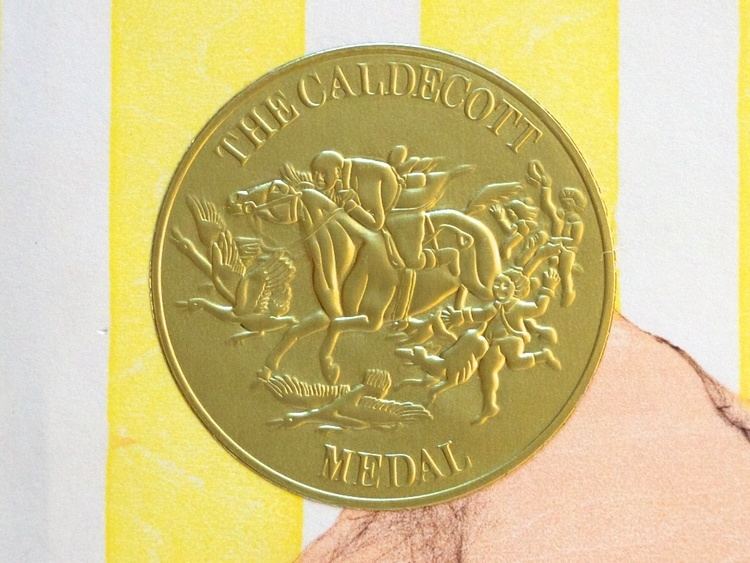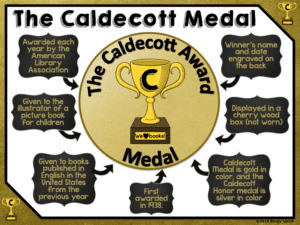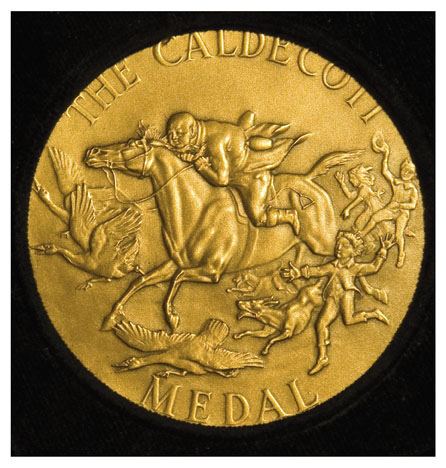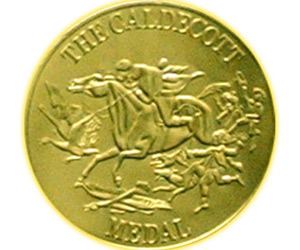Country United States Established 1937 Category of Caldecott Medal | Official website ala.org/alsc/caldecott First awarded 1938 People also search for John Newbery Medal | |
 | ||
Ceremony date January 23, 2017, 5:00 AM PST Presented by | ||
The Randolph Caldecott Medal annually recognizes the preceding year's "most distinguished American picture book for children", beginning with 1937 publications. It is awarded to the illustrator by the Association for Library Service to Children (ALSC), a division of the American Library Association (ALA). The Caldecott and Newbery Medals are the most prestigious American children's book awards.
Contents
- Illustrating caldecott books a celebration of 75 years of the caldecott medal
- Eligibility and criteria
- Process
- Recipients
- Multiple awards
- Caldecott Medals
- Medal and Honor Books
- References

The award is named for Randolph Caldecott, a nineteenth-century English illustrator. Rene Paul Chambellan designed the Medal in 1937. The obverse scene is derived from Randolph Caldecott's front cover illustration for The Diverting History of John Gilpin (Routledge, 1878, an edition of the 1782 poem by William Cowper), which depicts Gilpin astride a runaway horse. The reverse is based on "Four and twenty blackbirds baked in a pie", one of Caldecott's illustrations for the nursery rhyme "Sing a Song of Sixpence".

Beside the Caldecott Medal, the committee awards a variable number of citations to worthy runners-up, called the Caldecott Honors or Caldecott Honor Books. The "Honor" was introduced in 1971, but some runners-up had been identified annually and all those runners-up were retroactively named Caldecott Honor Books. The number of Honors or runners-up had always been one to five, and it had been two to four since 1994, until five were named in 2013 and six in 2015. The Honor Books must be a subset of the runners-up on the final ballot, either the leading runners-up on that ballot or the leaders on one further ballot that excludes the winner.
Illustrating caldecott books a celebration of 75 years of the caldecott medal
Eligibility and criteria

The artist must be a US citizen or resident and the illustrations must be original to the book, which must be published first or simultaneously in the US in English during the preceding year.
A picture book provides "a visual experience. A picture book has a collective unity of story-line, theme, or concept, developed through the series of pictures" that constitute the book. Picture books for any audience up to age 14 should be considered.
The Medal is "for distinguished illustrations in a picture book and for excellence of pictorial presentation for children". The book must be self-contained, independent of other media for its enjoyment. Components other than illustration should be considered as they bear on effectiveness as a children's picture book.
Process
The committee that decides on the Caldecott Award winner comprises fifteen members. Eight are elected by the entire ALSC membership and seven including the chairperson are appointed by the ALSC President. Many publishers send copies of books to the committee; 2009 members each received more than 700. To help identify possible contenders, the chairperson generally asks for committee members to identify strong contenders each month. In the fall each member of the committee may formally nominate seven books. Publications late in the year should receive equal consideration. As of 2009/2010 each committee member must nominate three and no more books in October, two in November, two in December, and January identification of worthy December publications is solicited.
Recipients
The latest winner of the Caldecott Medal, awarded in 2016, is Sophie Blackall for Finding Winnie: The True Story of the World’s Most Famous Bear, written by Lindsay Mattick (Little, Brown, 2015, OCLC 894149533).
The 2016 committee named four Caldecott Honor Books. The annual number of runners-up has ranged from one to six, same as for the Newbery Medal during the same timespan, from 1938. Indeed, for twenty years from 1993 to 2012 there were two to four Honors every year.
Yellow background highlights the Medalists.
Multiple awards
Robert Lawson alone has won both a Caldecott Medal and a Newbery Medal, the 1941 Caldecott for They Were Strong and Good and the 1945 Newbery for Rabbit Hill. He both wrote and illustrated both books.
Illustrator Gail E. Haley has won both the Caldecott and the Kate Greenaway Medal, the comparable British award for children's book illustration (not restricted to picture books). She won the Caldecott for A Story a Story (Atheneum Books, 1970) and the Greenaway for The Post Office Cat (The Bodley Head, 1976). Haley and her second husband lived in England from 1973 to 1980. From about 2000 the British award is open to all illustrators.
Jon Klassen became the second person to win both the Caldecott and the Greenaway and the first to win both for the same work: This Is Not My Hat won the Caldecott in 2013 and the Greenaway in 2014. It was released on October 9, 2012, by Walker Books in the UK and by its American subsidiary Candlewick Press in the US.
Caldecott Medals
Two people have won three Caldecott Medals.
Several others have won two medals:
Robert McCloskey, Barbara Cooney, Nonny Hogrogian, Leo and Diane Dillon, Chris Van Allsburg, Chris RaschkaMedal and Honor Books
Several winners of one Medal have also created multiple Honor Books.
7 honors: Maurice Sendak5 honors: Marie Hall Ets, Jerry Pinkney3 honors: Trina Schart Hyman, Blair Lent, Evaline Ness, Uri Shulevitz, Paul O. Zelinsky2 honors: Stephen Gammell, Berta and Elmer Hader, Kevin Henkes, Jon Klassen, Robert Lawson, Arnold Lobel, David Macaulay, Gerald McDermott, Leo Politi, Marc Simont, David Small, Leonard Weisgard, Ed Young, Margot Zemach